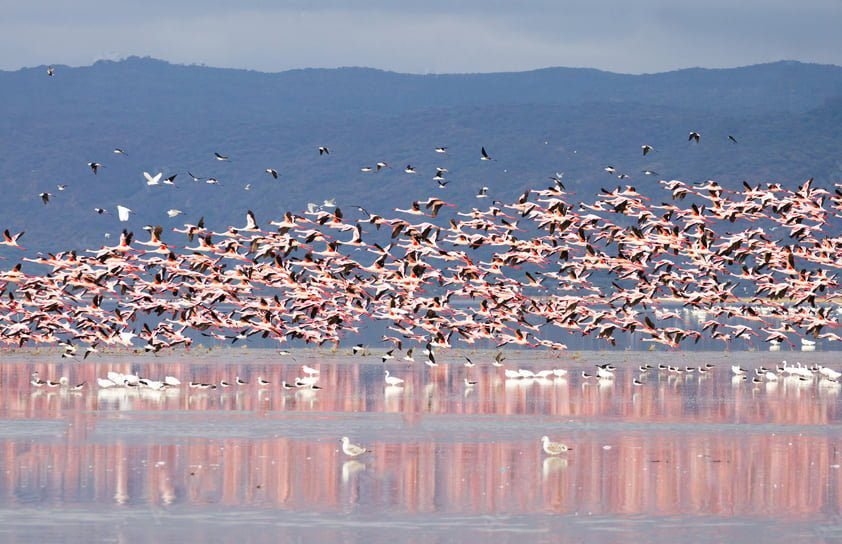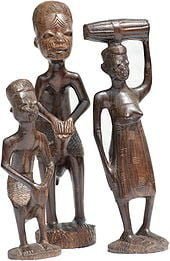Tanzania
Tanzania is probably one of the oldest known inhabited areas on Earth; fossil remains of humans and pre-human hominids have been found dating back over two million years.
More recently, Tanzania is believed to have been populated by hunter-gatherer communities, probably Cushitic and Khoisan speaking people. About 2,000 years ago, Bantu-speaking people began to arrive from western Africa in a series of migrations. Later, Nilotic pastoralists arrived, and continued to immigrate into the area through to the 18th century’
Two World Heritage Sites and two Biosphere Reserves have been established within the 30,000 km² region. It’s unique ecosystem has inspired writers from Ernest Hemingway to Peter Mattheissen, filmakers like Hugo von Lawick and Alan Root as well as numerous photographers and scientists.
East African coast
– Travellers and merchants from the Persian Gulf and western India have visited the East African coast since early in the first millennium AD
– Claiming the coastal strip, Omani Sultan Seyyid Said moved his capital to Zanzibar City in 1840. During this time, Zanzibar became the center for the Arab slave trade. Between 65% to 90% of the population of Arab-Swahili Zanzibar was enslaved.
– One of the most famous slave traders on the East African coast was Tippu Tip, who was himself the grandson of an enslaved African.
– The Nyamwezi slave traders operated under the leadership of Msiri and Mirambo. Timothy Insoll said, “Figures record the exporting of 718,000 slavesfrom the Swahili coast during the 19th century, and the retention of 769,000 on the coast.”
Climate
Tanzania has a tropical climate. In the highlands, temperatures range between 10 and 20 °C – 50 and 68 °F during cold and hot seasons respectively.
The rest of the country has temperatures rarely falling lower than 20 °C (68 °F).
The hottest period extends between
November and February 25–31 °C – 77–87.8 °F
The coldest period occurs between
May and August 15–20 °C – 59–68 °F
Annual temperature is 32 °C (89.6 °F). The climate is cool in high mountainous regions.
Tanzania has two major rainfall regions. One is uni modal(December – April) and the other is bimodal (October – December and March – May).
The former is experienced in southern, south-west, central and western parts of the country, and the latter is found to the north and northern coast.
In the bimodal regime the March – May rains are referred to as the long rains or Masika, where as the October – December rains are generally known as short rains or Vuli.
As Tanzania lies in equator here the climate is hot and humid.
The easterlies winds cause rainfall in the eastern coastal region.
Language
Tanzanians see themselves as having two “official” languages, English and Swahili. Swahili is seen as the unifying language of the country between different tribes who each have their own tribal language; English serves the purpose of providing Tanzanians with the ability to participate in the global economy and culture. The first language typically learned by a Tanzanian is that of his or her tribe, with Swahili and English learned there after.
According to the official linguistic policy of Tanzania, as announced in 1984, Swahili is the language of the social and political sphere as well as primary and adult education, whereas English is the language of secondary education, universities, technology and higher courts.
Though the British government financially supports the use of English in Tanzania, its usage in the Tanzanian society has diminished over the past decades: In the seventies Tanzanian university students used to speak English with each other, whereas now they almost exclusively use Swahili outside the classroom. Even in secondary school and university classes, where officially only English should be used, it is now quite common to use a mix of Swahili and English.
Other spoken languages are Indian languages, especially Gujarati, and Portuguese (spoken by Indians and Mozambican blacks, respectively) and to a lesser extent French (from neighboring Rwanda, Burundi and Democratic Republic of the Congo). Historically German was widely spoken during that colonial period, but few remain alive who remember that time.
Demographics
As of 2006, the estimated population is 38,329,000, with an estimated growth rate of 2 percent. Population distribution is extremely uneven, with density varying from 1 person per square kilometer (3/mi²) in arid regions to 51 per square kilometer (133/mi²) in the mainland’s well-watered highlands, to 134 per square kilometer (347/mi²) on Zanzibar.
More than 80 percent of the population is rural. Dar es Salaam is the largest city and is the commercial capital; Dodoma, located in the center of Tanzania is the new capital and houses the Union’s Parliament. The African population consists of more than 120 ethnic groups.
Geography
At 947,300 km2Tanzania is the world’s 31st-largest country. Compared to other African countries, it is slightly smaller than Egypt and comparable in size to Nigeria. Landscape in Northern Tanzania, inside the Great Rift Valley.
Tanzania is mountainous in the northeast, where Mount Kilimanjaro, Africa’s highest peak, is situated. To the North and west are the Great Lakes of Lake Victoria (Africa’s largest lake) and Lake Tanganyika which is Africa’s deepest lake, known for its unique species of fish.
Central Tanzania comprises a large plateau, with plains and arable land. The eastern shore is hot and humid, with the island of Zanzibar lying just offshore.
Tanzania contains many large and ecologically significant wildlife parks, including the famous Ngorongoro Crater, Serengeti National Park in the north, and Selous Game Reserve and Mikumi National Park in the south. Gombe National Park in the West is known as the site of Dr. Jane Goodall’s studies of chimpanzee behavior.
The government of Tanzania through its department of tourism has embarked on a campaign to promote the Kalambo water falls in the southwestern region of Rukwa as one of Tanzania’s main tourist destinations. The Kalambo Falls are the second highest in Africa and are located near the southern tip of Lake Tanganyika.
Environment
Tanzania has considerable wildlife habitat, including much of the Serengeti plain, where the white-bearded wildebeest (Connochaetes taurinus mearnsi) and other bovids participate in a large-scale annual migration.
Up to 250,000 wildebeest perish each year in the long and arduous movement to find forage in the dry season. Tanzania is also home to 130 amphibian and over 275 reptile species, many of them strictly endemic and included in the IUCN Red Lists of different countries
Tanzania has developed a Biodiversity Action Plan to address species conservation. A recently discovered species of elephant shrew called Grey-Faced Sengi was filmed first time in 2005, and it was known to live in just two forests in the Udzungwa Mountains. In 2008, it was listed as “vulnerable” on the 2008 Red List of Threatened Species. Lake Natron is northern Tanzania is the largest breeding site for the threatened Lesser Flamingo, a huge community of which nest in the salt marshes of the lake. Areas of East African mangroves on the coast are also important

Culture
 The music of Tanzania stretches from traditional African music to the string-based taarab to a distinctive hip hop known as bongo flava. Famous taarab singers names are Abbasi Mzee, Culture Musical Club, Shakila of Black Star Musical Group.
The music of Tanzania stretches from traditional African music to the string-based taarab to a distinctive hip hop known as bongo flava. Famous taarab singers names are Abbasi Mzee, Culture Musical Club, Shakila of Black Star Musical Group.
Internationally known traditional artists are Bi Kidude, Hukwe Zawose and Tatu Nane.
Tanzania has its own distinct African rumba music, termed muziki wa dansi (“dance music”) where names of artists/groups like Tabora Jazz, Western Jazz Band, Morogoro Jazz, Volcano Jazz, Simba Wanyika, Remmy Ongala, Marijani Shaabani, Ndala Kasheba, NUTA JAZZ, ATOMIC JAZZ, DDC Mlimani Park, Afro 70 & Patrick Balisidya, Sunburst, Tatu Nane and Orchestra Makassy must be mentioned in the history of Tanzanian music.
Tanzania has many writers. The list of writers’ names includes well-known writers such as Godfrey Mwakikagile, Mohamed Said, Abdulrazak Gurnah, Prof. Julius Nyang’oro, Prof. Clement Ndulute, Prof. Frank Chiteji, Prof. Joseph Mbele, Juma Volter Mwapachu, Prof. Issa Shivji, Jenerali Twaha Ulimwengu, Prof. Penina Mlama, Mwalimu Julius Kambarage Nyerere, Adam Shafi, Dr. Malima M.P Bundala and Shaaban Robert.
Tanzania has remarkable position in art. Two styles became world known: Tingatinga and Makonde.
Tingatinga are the popular African paintings painted with enamel paints on canvas. Usually the motifs are animals and flowers in colorful and repetitive design. The style was started by Mr. Edward Saidi Tingatinga born in South Tanzania. Later he moved to Dar Es Salaam. Since his death in 1972 the Tingatinga style expanded both in Tanzania and worldwide.
Makonde is both a tribe in Tanzania (and Mozambique) and a modern sculpture style. It is known for the high Ujamaas (Trees of Life) made of the hard and dark ebony tree. Tanzania is also a birthplace of one of the most famous African artists – George Lilanga.
Destination Tanzania - Volunteer in Africa
You can also watch this on Youtube
Visit Tanzania
You can also watch this on Youtube



